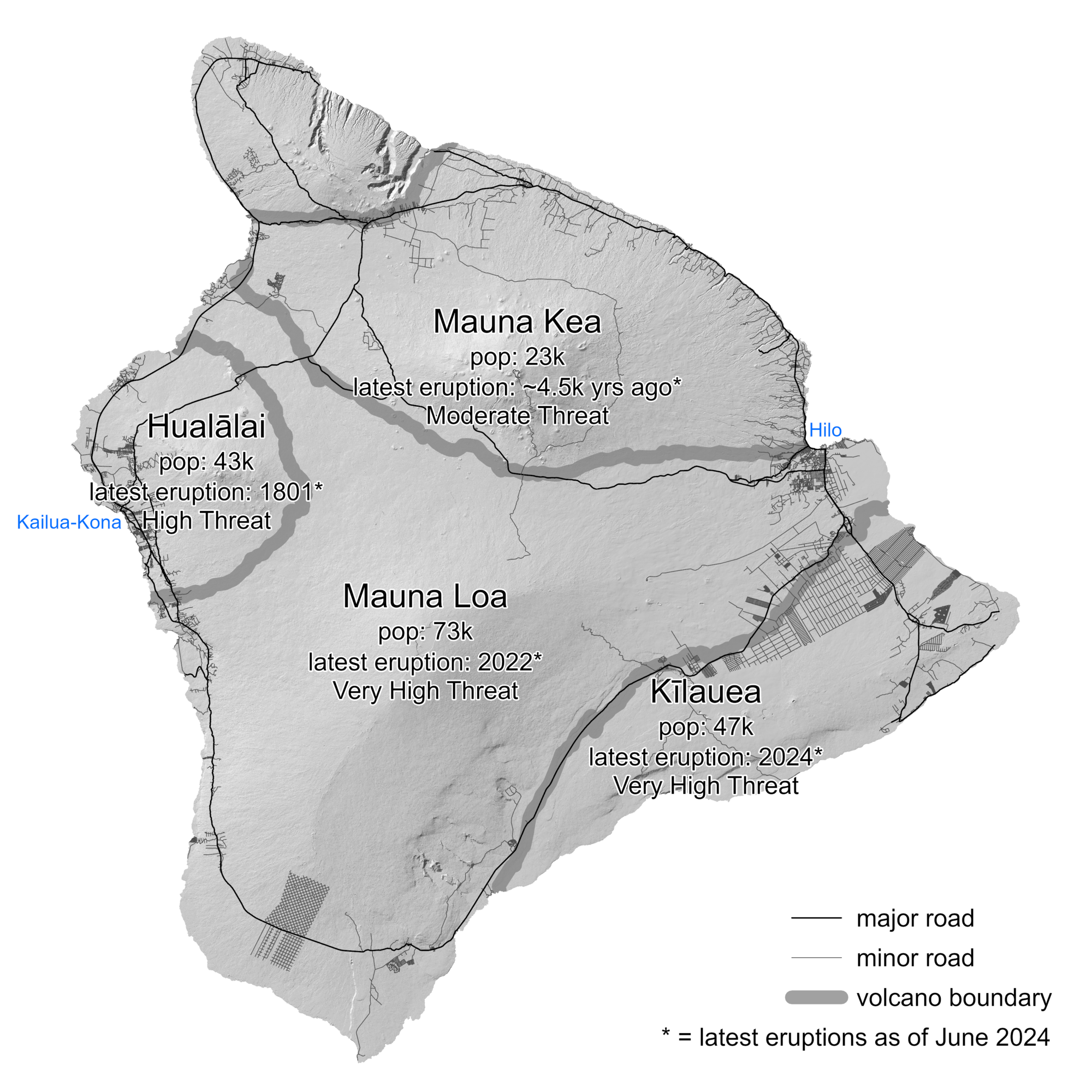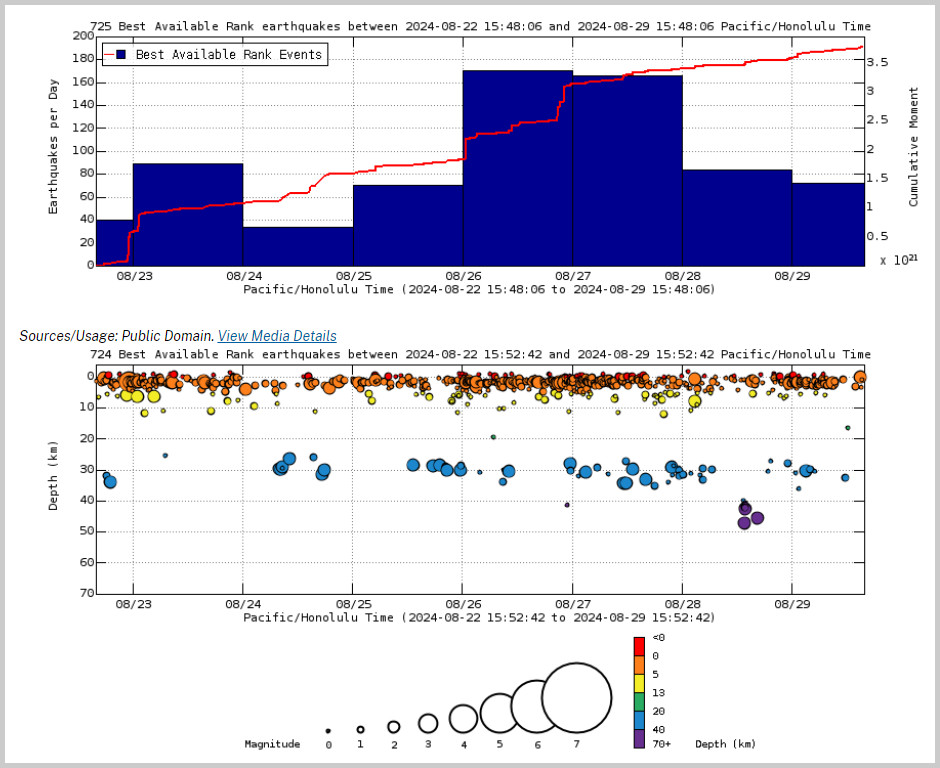 |
| Ash rises above Halema‘uma‘u within Kīlauea's summit caldera in this May 27, 2018, telephoto image from near Volcano House Hotel in Hawai‘i Volcanoes National Park. USGS photo |
ISLAND OF HAWAI'I INTERAGENCY OPERATIONS PLAN FOR VOLCANIC ERUPTIONS has been adopted. It is the subject of this week's
Volcano Watch, the weekly column by USGS Hawaiian Volcanoes Observatory scientists and affiliates. The partners in the plan are Hawaiʻi County Civil Defense Agency, Hawaiʻi Volcanoes National Park, and the U.S. Geological Survey Hawaiian Volcano. It can be read at
Ihttps://d9-wret.s3.us-west-2.amazonaws.com/assets/palladium/production/s3fs-public/media/files/island_of_hawaiBBi_interagency_plan_for_volcanic_eruptions_v1.0_july_2024_public.pdf.
Volcano Watch states, "While our three agencies have worked well responding to volcanic unrest and eruptions together for decades, the Interagency Volcano Plan puts our practices down on paper. We have developed it when our volcanoes have been relatively quiet—away from the stress of a crisis response—to make deliberate choices and decisions on how we can best serve our community and visitors to the Island of Hawaiʻi going forward, strengthening the partnership between the three agencies in the process.
 |
Map of Island of Hawaiʻi, highlighting the four active
or potentially active volcanoes of the Island, the number
of people living on each volcano based on 2020 census
data, major roads (transportation corridors) and minor roads
(proxy for population density), when each volcano last erupted,
and each volcano's national threat assessment designation.
|
Why is the Interagency Volcano Plan needed? The Island of Hawai'i consists of five volcanoes. Four volcanoes (Kīlauea, Mauna Loa, Hualālai, and Mauna Kea) are considered active and three of them have erupted since the year 1800. Based on 24 factors including eruptive history, eruptive style and associated hazards, and population exposure, the
2018 Update to the U.S. Geological Survey National Volcanic Threat Assessment identified Kīlauea and Mauna Loa as very high threat volcanoes, Hualālai as a high threat volcano, and Mauna Kea as a moderate threat volcano. For context, there are only 18 very high threat volcanoes in the
United States.
Volcanic eruptions in Hawaii can profoundly impact local communities, infrastructure, human health, agriculture, businesses, and tourism. A well-coordinated volcanic incident response can minimize loss of life, injury, social and economic disruption, and long-term consequences. This requires timely, accurate, relevant, and trusted information to threatened and impacted communities, and to the general population for situational awareness.
In 2018,
lava flows from the lower East Rift Zone of Kīlauea destroyed 612 residences. At Kīlaueaʻs summit, Hawaiʻi Volcanoes National Park and neighboring communities were affected by
thousands of earthquakes as the summit incrementally collapsed over the course of three months during the same eruption. In 2022,
Mauna Loa erupted for the
first time in 38 years; fortunately, the impacts were minimal. HVO monitored these volcanic events, working closely with landholding agencies such as the Hawaiʻi Volcanoes National Park, and emergency managers, led by the Hawaiʻi County Civil Defense Agency.
The Interagency Volcano Plan draws on the formal and informal USGS after-action reviews for the
2018 Kīlauea and 2022 Mauna Loa eruptions, respectively, to improve planning and response protocols. The development of the Interagency Volcano Plan spanned nearly two and a half years—interrupted by Covid-19 outbreaks, 6 eruptions, and other emergency responses—building on regular discussions between the three agencies on how to best work together during volcanic crises. It draws from elements of other U
SGS volcano observatories' interagency coordination plans but is uniquely developed for the Island of Hawaiʻi.
 The Interagency Volcano Plan addresses volcanic unrest and eruption response coordination on the Island of Hawaiʻi. Unrest hazards may include seismicity, ground deformation (including ground cracks and subsidence), volcanic gases and air pollution (vog), and associated hazards. Not all unrest leads to an eruption. Eruptive hazards may include all the unrest hazard and also active vents (including fissures), lava flows, lava bombs, tephra fall (including ash), laze, and (rare in Hawaii) pyroclastic density currents.
The Interagency Volcano Plan addresses volcanic unrest and eruption response coordination on the Island of Hawaiʻi. Unrest hazards may include seismicity, ground deformation (including ground cracks and subsidence), volcanic gases and air pollution (vog), and associated hazards. Not all unrest leads to an eruption. Eruptive hazards may include all the unrest hazard and also active vents (including fissures), lava flows, lava bombs, tephra fall (including ash), laze, and (rare in Hawaii) pyroclastic density currents.
The Interagency Volcano Plan is intended to be a guide, as each volcanic incident is unique. It is supported by detailed Standing Operating Guidelines and/or Standing Operating Procedures maintained by each participating agency. The Interagency Volcano Plan documents how the three agencies work together during volcanic crises, with the understanding that circumstances may require situation-specific changes and adaptations. It covers the roles and responsibilities of each agency, how notification of a volcanic situation is completed, jurisdictional areas of responsibility, incident command, information flow, and aviation coordination.
The three agencies that are part of this first version of the Interagency Volcano Plan are based on the Island of Hawaiʻi and were identified as having the most significant opportunities to improve interagency coordination in the USGS 2018 Kīlauea eruption after-action review. Additional agencies will be incorporated in future versions of the Interagency Volcano Plan, and work on version 2 is slated to start in October 2025.
USGS Volcano Activity Updates
Kīlauea is not erupting. Its USGS Volcano Alert level is ADVISORY. Seismic activity and ground deformation continues at Kīlauea's summit and upper-to-middle East Rift Zone. Over the past week, about 400 earthquakes were detected beneath Kīlauea's upper East Rift Zone and about 100 events were detected between Maunaulu and Puʻuʻōʻō in the middle portion of the East Rift Zone within Hawaiʻi Volcanoes National Park. Over the past week, Kīlauea's summit showed overall slow inflation with relatively little ground deformation recorded in the upper-to-middle East Rift Zone regions. Unrest may continue to wax and wane with changes to the input of magma in these areas; changes can occur quickly, as can the potential for eruption.
Mauna Loa is not erupting. Its USGS Volcano Alert Level is at NORMAL.
One earthquake was reported felt in the Hawaiian Islands during the past week: A M3.0 earthquake 7 km (4 mi) NE of Honoka'a at -1 km (0 mi) depth on August 28 at 8:22 p.m. HST.
HVO continues to closely monitor Kīlauea and Mauna Loa.
Visit HVO's website for past
Volcano Watch articles, Kīlauea and Mauna Loa updates, volcano photos, maps, recent earthquake information, and more. Email questions to askHVO@usgs.gov.
To read co
mments, add your own, and like this story, see facebook.com/kaucalendar. See upcoming events, print edition and archive at
kaunews.com. Support this news service with advertising at
kaunews.com. 7,500 copies in the mail and on stands.
THE FIRST KAʻŪ TARO FESTIVAL has been announced. It is planned for Saturday, Dec.14, from noon to 5 p.m. at Kaʻū Herkes District Gym complex in Pāhala.
The sponsoring organization is 'O Ka'ū Kākou, which sent out a statement saying it is "very excited and proud to announce the first annual, first on the Big Island, Kalo Festival." It is called Kāniwala Kalo O Ka'ū.
OKK invites the community to "celebrate all things Kalo!" The afternoon will feature live musical entertainment, hula dancers, lucky number prize drawings.
There will be a Kalo Mō'i and Mō'iwahine (King & Queen) coronation ceremony. Ka’ū residents under the age of 25 are eligible. Contestants must be able to attend the event for the Coronation Ceremony and participate in the Pahala Lighted Christmas Parade that evening on a parade float.
The event is slated as "a time to stock up for your holiday feasts and gifts." The Taro Festival will feature a wide array of vendors to include foods, arts, crafts, jewelry, live plants, baked goods and more. OKK seeks those who may be able to present the following: laulau, kulolo, live kalo plants and corms, taro leaf, poi, taro chips, squid luau, laulau stew, kalo apparel items, kalo print items, kalo prints and photography, kalo jewelry, kalo carvings kalo paintings, kalo tea and anything else involving kalo.
All money raised from this event by 'O Ka'ū Kākou will go to the OKK Scholarship Fund and to the OKK Ka'ū Educational Center.
The Pāhala Lighted Christmas Parade follows the festival at 6 p.m.
'O Ka'ū Kākou welcomes sponsors and vendors who wish to have a booth at the event and contestants for the Kalo Mō'i and Mō'iwahine court. For more details, see
www.okaukakou.org/kau-taro-festival. "Come for the Kalo, stay for the parade!," says the announcement.
FROM CONFLICT TO CONNECTION: BUILDING STRONGER RELATIONSHIPS is the September topic for the non-profit Ku'ikahi Mediation Center's Finding Solutions, Growing Peace, Brown Bag Lunch Series. Talks are Third Thursdays from noon to 1 p.m. via Zoom.
This month's speaker on Sept. 19 is Kathy Tan who advises, "Conflict is inevitable,"but how we respond to it can make all the difference in our relationships. In truth, conflict is an opportunity for growth."
The announcement said participants can "Learn practical tools and strategies to shift from adversarial
to collaborative approaches, fostering empathy, understanding, and constructive communication. Equip yourself to prevent and resolve conflicts at work, at home, and in the community."
Tan, M.A. is founder and CEO of Amalu Coaching, LLC, which provides empowerment coaching "grounded in trauma-informed and equity-centered practices." With a master's degree in Social Entrepreneurship & Change, she focuses on leadership development, employee well-being, and team cohesion. "Tan's expertise in diversity, equity, inclusion, and domestic violence peer counseling fosters inclusive, high-performing environments," according to Ku'ikahi Mediation.
Ku'ikahi's Brown Bag Lunch Series is free and open to the public. Attendees are encouraged to enjoy an informal and educational talk-story session and connect with others interested in Finding Solutions, Growing Peace.
To get the Zoom link, register online at
https://freebrownbagtalk.eventbrite.com. For more information, contact Ku'ikahi Mediation Center at (808) 935-7844 ext. 3 or
shelby@hawaiimediation.org. Or visit
www.hawaiimediation.org.
This lunch-and-learn series is made possible thanks in part to funding from the County of Hawai'i and Hawai'i Island United Way.
.jpg)
.JPG)

.jpg)

















-1.jpg)











.jpeg)